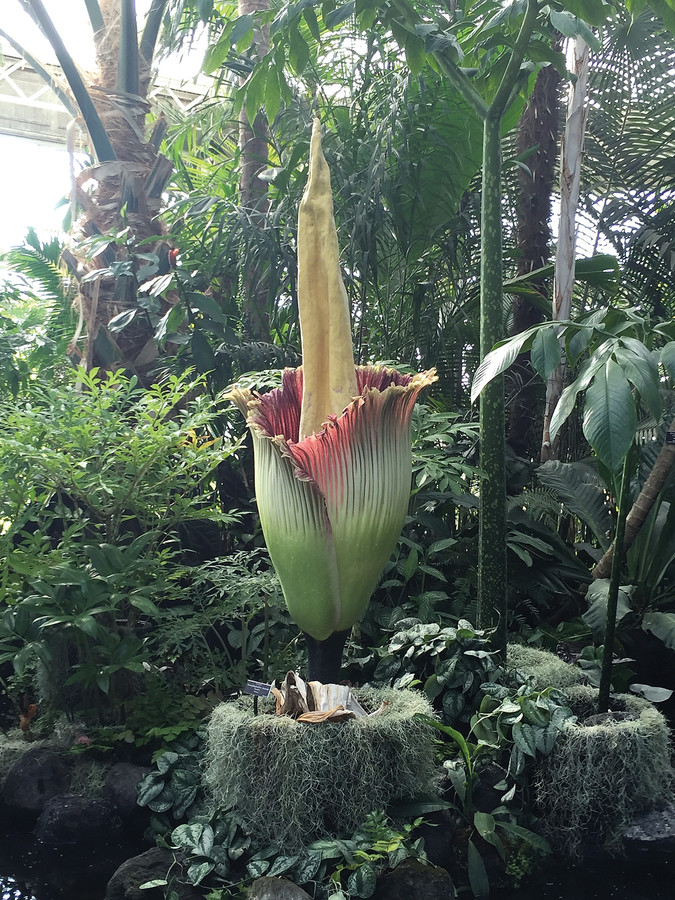At the end of the corpse flowers bloom, botanists’ work has just begun
The Amorphophallus excitement really should be over. The flower finally bloomed and after 36 hours, the huge spathe — the petal-like outer covering — closed up again, leaving the New York Botanical Garden (NYBG) to settle down for the next 10 years until the next Amorphophallus bloom.
I have had the privilege of volunteering at NYBG for several years and usually work at the Nolen Greenhouse in the succulent/cactus room. Tuesday after the blooming, I came as usual and found the Amorphophallus inflorescence sitting quietly in its pot in a hallway.
The spadix looked somewhat worse for the wear, but the whole structure was intriguing to see up close. I expected that it would be returned to its normal growing area and essentially retired.
Later, a whole group of people were standing around it with an air of eager anticipation. There were people from public relations who were preparing live-streaming videos for Facebook. The videos were going to document the steps that the scientists at NYBG were going to take to preserve material from the spent inflorescence for future research.
Last week I wrote that the Amorphophallus is not self-fertile. In an effort to obtain seed from the NYBG bloom, attempts were made to obtain pollen from another garden with a blooming plant. Alas, the pollen did not arrive on time, and the NYBG plant could not be fertilized.
However, that does not mean that its own pollen could not be sent onward to another garden where it could be put to good use. Marc Hachadourian, manager of the Nolen Greenhouses for Living Collections, cut open the inflorescence to remove pollen, which was shipped immediately to two other gardens with Amorphophalli on the verge of blooming.
Later, these gardens will also harvest pollen and send it onward to other gardens – paying the gift forward – so that with any luck, some of these flowers can be successfully fertilized to produce viable seed, from which new plants will be grown. And the cycle continues.
Using a razor, Marc Hachadourian first cut a window into the spathe, which was about 3/4 of an inch thick and resembled the skin of a watermelon. Since the last Amorphophallus bloom was in 1939, this was a first ever experience for him and all those present. Everybody crowded around, peering intently into a seemingly secret chamber.
Then, he cut completely around the base of the spathe and removed it entirely, revealing the inner structures. He described the upper part of the spathe as having a rubbery texture. The pollen structures lie in a ring above the female flowers. First, by hand, he brushed the pollen downward onto a sheet of paper.
Since that did not yield much material, he then used a paintbrush to reach inside and wipe off more pollen, which had shaken loose from the anthers and was clinging to the unreceptive female structures.
Then Daniel Atha, conservation program manager, took over. The next step was to preserve material in a way that would show future botanists how the plant actually looked.
This would then be used in identifying future specimens. That process involved cutting off pieces from various parts of the plant – the spathe with the frilly, red upper edge and the top 8 inches of the spadix – and preparing a herbarium sheet.
Here, the plant material is laid out, first on a newspaper sheet. This is then laid upon a paper sheet measuring 11.5 by 16.5 inches. This sandwich is then held together with a press, and will be subjected to an artificial heat source to drive out all the moisture. The newsprint sheet is ideal for wicking out the moisture.
The paper sheet will later be stored in the Herbarium – a collection of plant specimens – where it will be available for further study. Incidentally, the top of the spadix, when opened, resembled a loofah sponge filled with a network of fibers. A cross-section of the base of the spadix resembled a squash pith – although the plants are not related – and the texture of the sections through the female structures felt like Styrofoam.
The second process, used to preserve material for DNA studies, involves storing some of the material in silica gel. The third process, which is intended to preserve material for use in morphological – anatomical – studies, consisted of immersing slices of male and female tissue in a preservative solution composed of formaldehyde, acetic acid and ethanol. This solution will maintain the material indefinitely.
Despite the public and personal interest in this rare event, barring further surprises, I expect to move along to another topic in the next column.






